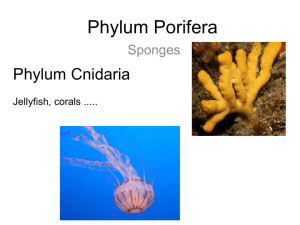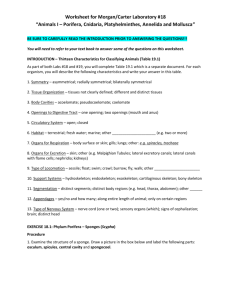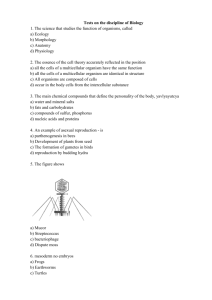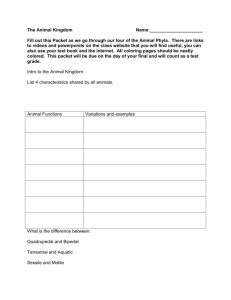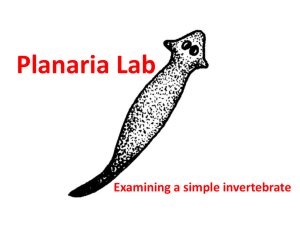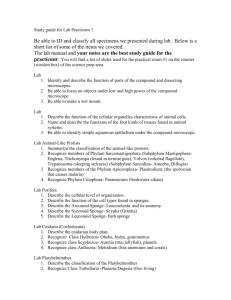What is a Planarian?
advertisement
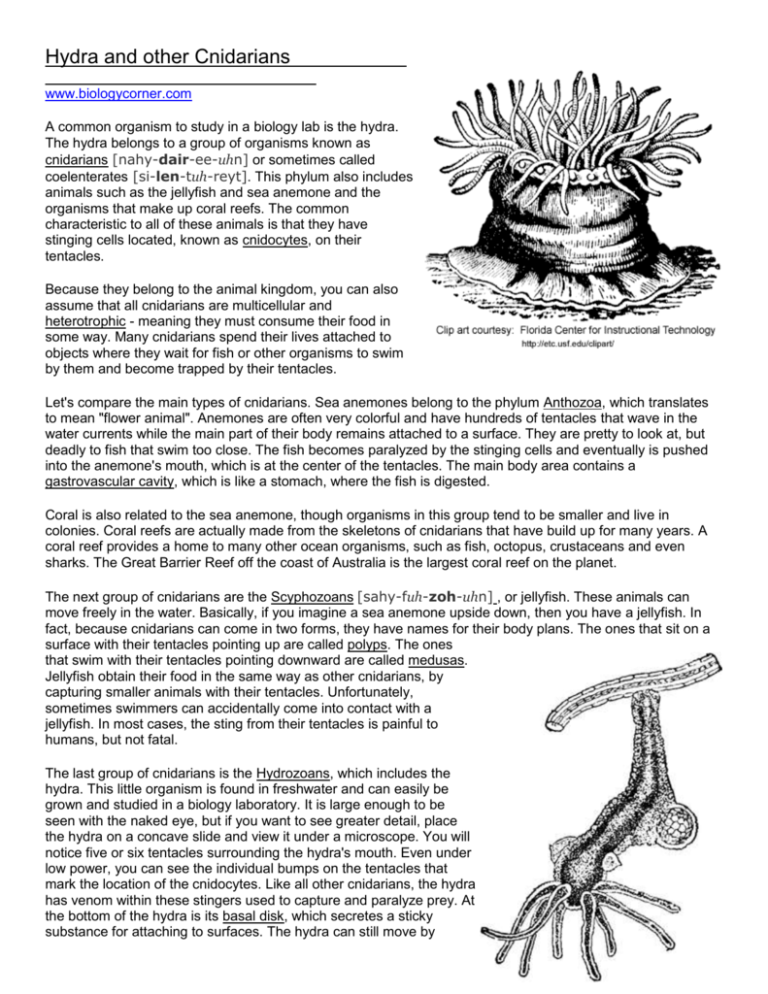
Hydra and other Cnidarians www.biologycorner.com A common organism to study in a biology lab is the hydra. The hydra belongs to a group of organisms known as cnidarians [nahy-dair-ee-uhn] or sometimes called coelenterates [si-len-tuh-reyt]. This phylum also includes animals such as the jellyfish and sea anemone and the organisms that make up coral reefs. The common characteristic to all of these animals is that they have stinging cells located, known as cnidocytes, on their tentacles. Because they belong to the animal kingdom, you can also assume that all cnidarians are multicellular and heterotrophic - meaning they must consume their food in some way. Many cnidarians spend their lives attached to objects where they wait for fish or other organisms to swim by them and become trapped by their tentacles. Let's compare the main types of cnidarians. Sea anemones belong to the phylum Anthozoa, which translates to mean "flower animal". Anemones are often very colorful and have hundreds of tentacles that wave in the water currents while the main part of their body remains attached to a surface. They are pretty to look at, but deadly to fish that swim too close. The fish becomes paralyzed by the stinging cells and eventually is pushed into the anemone's mouth, which is at the center of the tentacles. The main body area contains a gastrovascular cavity, which is like a stomach, where the fish is digested. Coral is also related to the sea anemone, though organisms in this group tend to be smaller and live in colonies. Coral reefs are actually made from the skeletons of cnidarians that have build up for many years. A coral reef provides a home to many other ocean organisms, such as fish, octopus, crustaceans and even sharks. The Great Barrier Reef off the coast of Australia is the largest coral reef on the planet. The next group of cnidarians are the Scyphozoans [sahy-fuh-zoh-uhn] , or jellyfish. These animals can move freely in the water. Basically, if you imagine a sea anemone upside down, then you have a jellyfish. In fact, because cnidarians can come in two forms, they have names for their body plans. The ones that sit on a surface with their tentacles pointing up are called polyps. The ones that swim with their tentacles pointing downward are called medusas. Jellyfish obtain their food in the same way as other cnidarians, by capturing smaller animals with their tentacles. Unfortunately, sometimes swimmers can accidentally come into contact with a jellyfish. In most cases, the sting from their tentacles is painful to humans, but not fatal. The last group of cnidarians is the Hydrozoans, which includes the hydra. This little organism is found in freshwater and can easily be grown and studied in a biology laboratory. It is large enough to be seen with the naked eye, but if you want to see greater detail, place the hydra on a concave slide and view it under a microscope. You will notice five or six tentacles surrounding the hydra's mouth. Even under low power, you can see the individual bumps on the tentacles that mark the location of the cnidocytes. Like all other cnidarians, the hydra has venom within these stingers used to capture and paralyze prey. At the bottom of the hydra is its basal disk, which secretes a sticky substance for attaching to surfaces. The hydra can still move by floating and also by doing a characteristic cartwheel where it flips over onto its tentacles and then pops back to its original orientation. You may even be able to see the hydra eat by placing a small organism, such as daphnia or brine shrimp on the slide. When these organisms swim close to the hydra, they will immediately be grabbed by the tentacles and consumed. Because the hydra does not have a separate opening for waste, any material that cannot be digested is regurgitated out of its mouth. Cnidarians do not have a head or a brain or other organs that we find familiar to animals. It is amazing that they can live, eat, and respond to their environment. Instead of a brain, their bodies have a nerve net, which is used to coordinate their movements and respond to the environment. Most cnidarians can regenerate their tentacles or other damaged body parts. In fact, they can even grow a whole new body attached to their main body. This smaller version of themselves is called a bud and is a form of asexual reproduction. Questions 1. To what kingdom do cnidarians belong? a. Animalia b. Porifera c. Cnidaria 2. What could a hydra eat? a. algae b. brine shrimp c. jellyfish 3. Which of the following remains mostly stationary, attached to surfaces? a. jellyfish b. sea anemone c. hydra 4. A "bud" is formed by a hydra as a means of: a. defense b. swimming c. reproduction 5. Anthozoans were named such because: a. they looked like flowers b. they were found near Anthoa c. they have stingers 6. Which cnidarians is most likely to be studied in a biology class? a. jellyfish b. sea anemone c. hydra 7. Which of the following characteristics are common to ALL cnidarians? a. stinging cells b. live in oceans c. medusa body form 8. How does a hydra remove wastes or undigested material? a. exits through an anus b. regurgitated from the mouth c. absorbed through the tentacles 9. Jellyfish belong to the Phylum ______ and the Class ______. a. Cnidaria, Anthozoa b. Scyphozoa, Cnidaria c. Cnidaria, Scyphozoa 10. What structure allows a jellyfish (and other cnidarians) to respond to its environment? a. central nervous system b. nerve net c. gastrovascular cavity Hydra Lab Prelab Questions: 1. The Hydra belongs to the Kingdom ___________________________ and the Phylum ____________________________________________ 2. What are cnidocytes? 3. Where do hydra live? 4. Name two other organisms that are closely related to the hydra. 5. Obtain a slide of a living hydra and observe under scanning and low power. Note that you do not have a cover slip on the slide so you should NOT use the high power objective. The hydra is visible on the slide without the microscope. Make a sketch of your hydra. 6. Because the hydra moves around on the slide, it can be difficult to get a good view of it. Your teacher may provide you with a "Preserved Hydra" slide which contains a hydra that has been fixed to the slide. This hydra is no longer living. Sketch your preserved slide below (or living hydra) and label it. Hydra at scanning (40x) Hydra Tentacle at low power (100x) Label the: Basal disk | Tentacles | Gastrovascular cavity (area) | Cnidocytes | Mouth | Bud (if present) | 7. Count the number of tentacles on your hydra. How many does it have? ____________ Compare this number to other hydras. Are all hydras the same? _______ 8. Hydra Behavior - Use a dissecting pin to gently touch your hydra. Describe its reaction. *You may also try adding fish flakes or live Daphnia to your slide to see if you can observe the hydra eating. Hydra Lab Prelab Questions: 1. The Hydra belongs to the Kingdom ___Animalia________ and the Phylum _______Cnidaria____________________ 2. What are cnidocytes? stinging cells 3. Where do hydra live? fresh water 4. Name two other organisms that are closely related to the hydra. jellyfish, coral 5. Obtain a slide of a living hydra and observe under scanning and low power. Note that you do not have a cover slip on the slide so you should NOT use the high power objective. The hydra is visible on the slide without the microscope. Make a sketch of your hydra. 6. Because the hydra moves around on the slide, it can be difficult to get a good view of it. Your teacher may provide you with a "Preserved Hydra" slide which contains a hydra that has been fixed to the slide. This hydra is no longer living. Sketch your preserved slide below (or living hydra) and label it. Hydra at scanning (40x) Hydra Tentacle at low power (100x) Label the: Basal disk | Tentacles | Gastrovascular cavity (area) | Cnidocytes | Mouth | Bud (if present) | 7. Count the number of tentacles on your hydra. How many does it have? ____varies, 7-9 is most common___ Compare this number to other hydras. Are all hydras the same? __no____ 8. Hydra Behavior - Use a dissecting pin to gently touch your hydra. Describe its reaction. it will scrunch into a ball, or move *You may also try adding fish flakes or live Daphnia to your slide to see if you can observe the hydra eating. hydras often don't cooperative with being fed, if you're lucky you can see a daphnia being eaten. Name: ______________________________ Observation of a Live Planarian You will receive a small petri dish with a flatworm inside it. The flatworm is the freshwater planarian, also known as Dugesia. For more information on the planarian, check out this Article on the Planarian or read the related chapter in your textbook. Prelab Questions 1. To what kingdom do planarians belong? ________________________ What phylum? __________________ 2. Planarians have bilateral symmetry. What does that mean? 3. Where do planarians live? Observations and Experiments on the Flatworm 4. Observe your worm, using a microscope or hand lens. Sketch the planarian below. Label the eyespots. Label the anterior and posterior ends. Pay attention to detail on your sketch! 5. Measure your planarian. This operation is best performd by removing some of the water from the dish and waiting for the worm to stretch out. Measure the length of the worm in millimeters. (Always replace the water, you can use the dish lid to transfer water to and from the planarian environment.) .................................................................... Length of Planarian _______ Write your length on the board and when all the lengths are down, determine the average planarian size. Average ___________ How does your planarian comapare? 6. Observe the planarian for five minutes. Does the planarian seem active or passive? How does it move? Does it swim or creep? Where in the dish does it spend most of its time? Make a current in the water with a pipette. How does the planarian react? Fill out the table below. Description Movement Worm Location Reaction to Current 7. Planarians actually display a handedness, being right or left handed. You can discover whether your worm is right or left handed by flipping the planarian over on its dorsal (back) and seeing which way it recovers. If it rolls to the right, it is right handed, if it rolls to the left, it is left handed. Do five trials to determine the handedness of your planarian. Trial 1 Trial 2 Trial 3 Trial 4 Which way did it roll? Based on your data, is your planarian right or left handed? ____________ Trial 5 8. Design an experiment to test the planarians reaction to light and dark. You will have flashlights and the room will be darkened for this part of the lab. Describe your experiment and be detailed enough that someone else could perform the exact same experiment. You can even use a numbered list to describe your procedure. Conduct your experiment to determine whether the planarian prefers light or dark. Construct a data table. Write your conclusions. Make sure you answer the question: Does the planarian prefer a light or dark environment and include your reasoning. 9. Drop a piece of food into the petri dish with the planarian. Observe the planarian's reactions. It may take a few minutes. How does it eat the food? Where is its mouth? Use the space below to write your observations. What is the name of the tube used for feeding in the planarian? Planarian Reproduction 10. Planarians are hermaphrodites. Define hermaphrodite 11. Planarians can also reproduce by regeneration.Define regeneration Is this method of reproduction sexual or asexual? 12. Your teacher will cut a planarian on half for you. Observe the two pieces of the planarian under the microscope or with a hand lens. Describe how each of the cut halves is behaving. Are they both moving? Is one moving more than the other? Is there obvious damage to the tissue of the animal? Make a prediction: How long do you think (in days) will it take for your planarian to completely regenerate? What is a Planarian? Planaria are free-living flatworms that live in quiet ponds or bodies of water. In some areas you can even catch a few planarian by attaching a piece of liver to a fish hook and a sinker and dropping it into the water. Wait a few minutes and pull the liver out and you may find tiny little black worms feasting on the meat. Like all flatworms, planaria belong to the Kingdom Animalia, and the Phylum Platyhelminthes. This phylum also contains parasitic flatworms, like the tapeworm and the liver fluke. Free-living flatworms like the planaria are grouped into the Class Turbellaria. The most common species studied in the lab is the brown planaria, Dugesia. The animal has an acoelomate body (no internal cavity to hold organs), no anus and lacks a circulatory system. Most are scavengers and will eat other animals that have sank to the bottom of their ponds, hence why you can use liver to capture them. The Dugesia does have a simple nervous system that includes a ganglia located in its anterior region to serve as a brain. As such, the dugesia exhibits the trait of cephalization, where the majority of its sense organs are located in the anterior region. It has a triangular head with two prominent eyespots. Upon closer inspection of the eyes, you can see that they have a curious cross-eyed expression to them. The presence of the two eyes and lateral horns on the head indicate that the planarian has bilateral symmetry. The planarian will swim in a shallow petri dish by undulating its body across the surface of the dish. Most will stay close to the bottom or the edge of the dish. If given a choice, the planarian will actively seek an area of the dish that is dark or has some kind of cover. The eyespots can in fact, detect changes in light in the planarian's environment. If you shine a flashlight on the planarian, it will attempt to move out of the light. The planarian does not have gills or lungs, it obtains its oxygen by simple diffusion over its flat body. The dugesia cannot survive outside of the water, so biologists studying it must make sure that the specimen has plenty of water that is aerated. The dugesia does have an excretory system to remove wastes. Tiny cells, called flame cells, line the lateral edge of the organism and function to remove waste. The dugesia can reproduce sexually, and all dugesia are hermaphrodites. Two dugesia will pair up and fertilize each other's eggs. Those eggs are then released in a cocoon. If there is not another dugesia present, one can reproduce asexually through a process called transverse fission. The organism will pull itself in half and the tail portion will regenerate a new head, and the head portion will regenerate a new tail. This process can be replicated in the lab by using a razor blade or scalpel to cut the dugesia in half. In a couple of weeks, you should have two dugesia swimming around in your petri dish. QUESTIONS 1. What type of symmetry does the dugesia have? radial bilateral asymmetry 2. What term is used to describe how a planarian can regrow its body parts? regeneration fission cephalization 3. Which of the following is associated with the planarian's nervous system? flame cells diffusion ganglia 4. Asexual reproduction can occur through a process called: transverse fission binary fission cocoooning 5. A hermaphrodite is an animal that: can asexually reproduce can regenerate has both male and female parts 6. The dugesia belongs to the phylum: platyhelminthes planaria turbellaria 7. How could a a person catch a dugesia? using a net to siphon them from the surface of the water using a hook and raw liver to attract them 8. An animal that has no internal body cavity to hold organs is called a(n): turbellarian hermaphrodite acoelomate 9. How does the dugesia obtain oxygen? diffusion through gills with its flame cells 10. The dugesia will tend to stay in what areas? dark light warm
